Kenji Doihara
| General Doihara Kenji | |
|---|---|
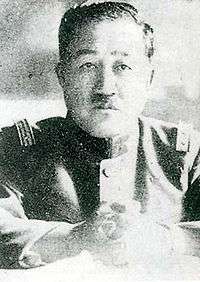 | |
| Nickname(s) | Lawrence of Manchuria, a reference to T. E. Lawrence |
| Born |
8 August 1883 Okayama prefecture, Japan |
| Died |
23 December 1948 (aged 65) Sugamo Prison, Tokyo, Japan |
| Allegiance | Empire of Japan |
| Service/branch | Imperial Japanese Army |
| Years of service | 1904–1945 |
| Rank | General |
| Commands held |
14th Division Fifth Army Seventh Area Army |
| Battles/wars |
Siberian Intervention Second Sino-Japanese War World War II |
Kenji Doihara (土肥原 賢二 Doihara Kenji, 8 August 1883 – 23 December 1948) was a general in the Imperial Japanese Army in World War II. He was instrumental in the Japanese invasion of Manchuria for which he earned fame taking the nickname 'Lawrence of Manchuria', a reference to Lawrence of Arabia, although according to Jamie Bisher this flattering sobriquet was rather misapplied given that Colonel T.E. Lawrence fought to liberate, not to oppress a people.[1] Furthermore, according to the opinion of his military chief in Manchuria, Lieutenant-General Ishiwara Kanji, his heavy addiction to opium contributed to his unreliability as an army officer.[2]
As a leading intelligence officer he played a key role to the Japanese machinations leading to the occupation of large parts of China, the destabilization of the country and the disintegration of the traditional structure of Chinese society in order to diminish reaction to the Japanese plans using highly unconventional methods. He became the mastermind of the Manchurian drug trade, and the real boss and sponsor behind every kind of gang and underworld activity in China (see Controversy section). After the end of World War II, he was prosecuted for war crimes in the International Military Tribunal for the Far East. He was found guilty, sentenced to death and was hanged in December 1948.
Biography
Early life and career
Kenji Doihara was born in Okayama city, Okayama Prefecture. He attended military preparatory schools as a youth, and graduated from the 16th class of the Imperial Japanese Army Academy in 1904. He was assigned to various infantry regiments as a junior officer, and returned to school to graduate from the 24th class of the Army Staff College in 1912.
Doihara longed for a high-ranking military career, but his family's low social status stood in the way. He therefore contrived to use his 15-year-old sister as a concubine for a prince, who in exchange, rewarded him with a military rank and a posting to the Japanese embassy in Beijing, China as assistant to the military attaché General Hideki Tōjō.[3][4][5] After that Doihara worked more easily his way up the military ladder by taking a number of regular army posts necessary as to earn promotions. He spent most of his early career in various postings in northern China, except for a brief tour in 1921-1922 as part of the Japanese forces in eastern Russia during the Siberian Intervention. He was attached to IJA 2nd Infantry Regiment from 1926 to 1927 and IJA 3rd Infantry Regiment in 1927. In 1927 he was part of an official tour to China and then attached to IJA 1st Division from 1927 to 1928.
He learned to speak fluent Mandarin Chinese, and other Chinese dialects and with this he managed to take a position to the military intelligence. From that post in 1928 It was he who masterminded the assassination of Zhang Zuolin, the Chinese warlord who controlled Manchuria on his way from Beijing to Shenyang ordering to blown up of his train at Shenyang. After that he was made military adviser to the Kuomingtang Government until 1929. In 1930 he was promoted to colonel and commanded IJA 30th Infantry Regiment.
Member of the "Eleven Reliable" clique

Doihara's performance was recognized, and by 1930 he was assigned to the Imperial Japanese Army General Staff Office. There, together with Hideki Tojo, Itagaki Seishirō, Daisaku Komoto, Yoshio Kudo, Masakasu Matsumara and others, he became a chosen member of the "Eleven Reliable" circle of officers. The Eleven Reliable clique was an external tool of a more closed group of three influential senior military officers called the "Three Crows" (Tetsuzan Nagata, Toshiro Obata and Yasuji Okamura) who wanted to modernize the Japanese military and to purge it of its anachronistic samurai tradition and the dominant allied clans of Chōshū and Satsuma that favored that tradition. The real sponsor behind both two bodies was Field Marshal Royal Prince Naruhiko Higashikuni, uncle and advisor of the Emperor Hirohito, and responsible for eight fake coups d'état, four assassinations, two religious hoaxes, and countless threats of murder and blackmails between 1930 and 1936 in his effort to neutralize the Japanese moderates, that opposed war, by spreading terror. Higashikuni highly favored covered work by faithful officers inside the intelligence departments in order to bring about the political program of his own clique named "Toseiha". This clique had a decisive materialistic, westernizing approach on the issue of the Empire's expansion, in a rather colonization-like fashion, as opposed to the rival "Kodoha" clique which was for a more "spiritual" way of expansion as an effort to liberate and unite all yellow race peoples under a racial, not nationalistic Empire. Kōdōha, headed by Gen. Sadao Araki, under the national socialistic, totalitarian and populistic philosophical influence of Ikki Kita charged Toseiha for collusion with the Zaibatsu financially conglomerate business clique, or simply put it, for amoralism and pro-capitalism.[6] It is not quite clear whether Doihara joined the movement for ideological or opportunistic reasons, but in any case, from then on his military career accelerated. In 1931 he became head of the military espionage operations of the Japanese Army of Manchuria in Tientsin. The following year he was transferred to Shenyang as head of the Houten Special Agency, the military intelligence service of the Japanese Kwantung Army.
The “Lawrence of Manchuria”

While at Tientsin, Doihara, together with Itagaki Seishirō engineered the infamous Mukden Incident by ordering Lieutenant Suemori Komoto to place and fire a bomb near the tracks at the time when a Japanese train passed through. In the event the bomb was so unexpectedly weak and the damage of the tracks so negligible that the train passed undamaged, but despite that, the Imperial Japanese Government blamed the Chinese military for an unprovoked attack, invaded and occupied Manchuria. During the invasion, Doihara facilitated the tactical cooperation between the Northeastern Army Generals Xi Qia in Kirin, Zhang Jinghui in Harbin and Zhang Haipeng at Taonan in the northwest of Liaoning province.
Next, Doihara took the task to return former Qing dynasty emperor Pu Yi to Manchuria as to give legitimacy to the puppet regime. The plan was to pretend that Pu Yi had returned to resume his throne by an imaginable popular demand of the people of Manchuria, and that although Japan had nothing to do with his return, it could do nothing to oppose the will of the people. In order to carry out this plan, it was necessary to land Pu Yi at Yingkou before that port froze; therefore, it was imperative that he arrived there before 16 November 1931. With the help of the legendary spy Kawashima Yoshiko, a woman well-acquainted with the Emperor, who regarded her as a member of the Chinese Imperial Family, he succeeded in bringing him into Manchuria within the deadline.
In early 1932 Doihara was sent to head the Harbin Special Agency of the Kwantung Army, where he began negotiations with General Ma Zhanshan after he had been driven from Tsitsihar by the Japanese. Ma's position was ambiguous; he continued negotiations while he supported Harbin-based General Ting Chao. When Doihara realized his negotiations were not going anywhere, he requested that Manchurian warlord Xi Qia advance with his forces to take Harbin from General Ting Chao. However, General Ting Chao was able to defeat Xi Qia’s forces and Doihara realized he would need Japanese forces to succeed. Doihara engineered a riot in Harbin to justify their intervention. This resulted in the IJA 12th Division under General Jirō Tamon coming from Mukden by rail and then marching through the snow to reinforce the attack. Harbin fell on 5 February 1932. By the end of February, General Ting Chao retreated into northeastern Manchuria and offered to cease hostilities, ending Chinese formal resistance. Within a month the puppet state of Manchukuo was established under Doihara's supervision who had named himself mayor of Mukden. He then arranged for the puppet government to ask Tokyo to supply "military advice". During the next months 150,000 soldiers, 18,000 gendarmes and 4,000 secret police came into the newly founded protectorate. He used them as an occupying army, imposing slave labour and spreading terror to force the 30 million Chinese inhabitants into abject submission.[7]
Ma's fame as uncompromised fighter against the Japanese invaders survived after his defeat, so Doihara made contact with him offering a huge sum of money and the command of the puppet's state army if he would defect to the new Manchurian government. Ma pretended that he agreed and flew to Mukden in January 1932 where he attended the meeting on which the state of Manchukuo was founded and was appointed War Minister of Manchukuo and Governor of Heilongjiang Province. Then, after using the Japanese funds to raise and re-equip a new volunteer force, on 1 April 1932 he led his troops to Tsitsihar, re-establishing the Heilongjiang Provincial Government as part of Republic of China and resumed the fight against the Japanese.
From 1932 to 1933 the newly promoted Major General Doihara commanded IJA 9th Infantry Brigade of IJA 5th Division. After the seizure of Jehol in Operation Nekka, Doihara was sent back to Manchukuo to head Houten Special Agency once again until 1934. He was then attached to IJA 12th Division until 1936.
Second Sino-Japanese War and Second World War
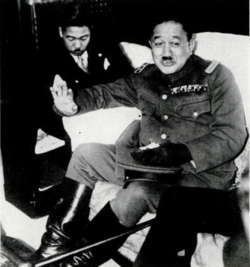
From 1936 to 1937 Doihara was the commander of the 1st Depot Division in Japan until the Marco Polo Bridge Incident, when he was given command of the IJA 14th Division under the Japanese First Army in North China. There he served in the Beiping–Hankou Railway Operation and spearheaded the campaign of Northern and Eastern Henan, where his division opposed the Chinese counterattack in the Battle of Lanfeng.
Following the Battle of Lanfeng, Doihara was attached to the Army General Staff as head of the Doihara Special Agency until 1939, when he was given command of the Japanese Fifth Army, in Manchukuo under the overall control of the Kwantung Army.
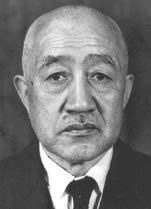
In 1940 Doihara became a member of the Supreme War Council which at that year shifted its military policy in China to what was called the Three Alls ("Kill all – Burn all – Loot all").[8] He then became head of the Army Aeronautical Department of the Ministry of War, and Inspector-General of Army Aviation until 1943. From 1940 to 1941 he was appointed Commandant of the Imperial Japanese Army Academy. On 4 November 1941, as a general in the Japanese Army Air Force and a member of the Supreme War Council he voted his approval of the attack on Pearl Harbor.
In 1943, Doihara was made Commander in Chief of the Eastern District Army. In 1944, he was appointed the Governor of Johor State, Malaya, and commander in chief of the Japanese Seventh Area Army in Singapore until 1945.
Returning to Japan in 1945, Doihara was promoted to Inspector-General of Military Training (one of the most prestigious positions in the Army) and commander in chief of the Japanese Twelfth Area Army. At the time of the surrender of Japan in 1945 Doihara was commander in chief of the 1st General Army.
Criminal activities
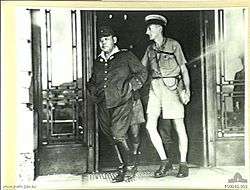
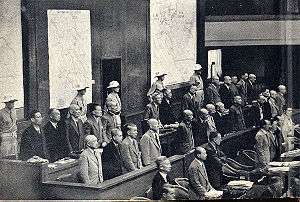

Doihara's activity in China vastly exceeded the normal behaviour of an intelligence officer. As chief of the Japanese secret services in China he worked out, put in motion and oversaw a wide series of activities systematically exploiting the occupied areas and disrupting Chinese social structure in the rest of the country in order to weaken public resistance. To this end, he used every possible kind of action, including deliberately fueling criminality, fostering drug addiction, sponsoring terrorism, assassinations, blackmail, bribery, opium trafficking and racketeering, spreading every kind of corruption in the almost ungovernable country.[9] The extent of his activities and covert operations are still inadequately understood. According to Ronald Sydney Seth, his activity played a key role in shattering China's ability to confront Japan's expansion by generating chaotic conditions which prevented any mass reaction in the invaded country.
After the occupation of Manchuria, under his supervision the Japanese secret service soon turned Machukuo into a vast criminal enterprise where rape, child molestation, sexual humiliation, sadism, assault and murder became institutionalized means of terrorizing and controlling Manchuria's Chinese and Russian population. Robbery by soldiers and gendarmes, arbitrary confiscation of property and unabashed extortion became commonplace. Underground brothels, opium dens, gambling houses and narcotics shops run by Japanese gendarmes competed with the state monopoly syndicate of opium. Many conscientious Japanese officers protested these conditions, but Tokyo ignored them and consequently they were silenced. The ritual suicide of Gensui Baron Mutō Nobuyoshi, who allegedly had left a note to the Emperor Hirohito pleading for mercy for the people of Manchuria, was in vain.[10]
Doihara soon expanded his activity into the still unoccupied parts of China. By using about 80,000 paid Chinese villains known as Chiang Mao Tao, he funded hundreds of criminal groups, using them for every kind of social disturbance, turnover, assassinations and sabotage inside unoccupied China. Through these organizations he soon managed to control a large part of the opium traffic in China, using the money earned to fund his covert operations.[11][12]
He hired an army of agents and sent them throughout China as representatives of various humanitarian organizations. They established thousands of health centers, mainly in the villages of the districts, for curing tuberculosis, which was then epidemic in China. By adulterating medicines with opium, he managed to addict millions of unsuspecting patients, expanding societal degeneration into areas which had been hitherto untouched by the increasing breakdown of Chinese society. This scheme also created a pool of addicted victims desperate to offer any kind of service to in order to secure a daily dose of opium.[13][14]
He initially gave food and shelter to tens of thousands Russian White émigré women who had taken refuge in the Far East after the defeat of the White Russian anti-Bolshevik movement during the Russian Civil War and the withdrawal of the Entente and Japanese armies from Siberia. Having lost their livelihoods, and with most of them widowed, Doihara forced the women into prostitution, using them to create a network of brothels throughout China where they worked under inhuman conditions. The use of heroin and opium was promoted to them as a way to tolerate their miserable fate. Once addicted, the women were used to further spread the use of opium among the population by earning one free opium pipe for every six they were selling to their customers.[15][16]
Winning the necessary support from the authorities in Tokyo he persuaded the Japanese tobacco industry Mitsui of Mitsui zaibatsu to produce special cigarettes bearing the popular to the Far East trademark "Golden Bat". Their circulation was prohibited in Japan, as they were intended only for export. Doihara's services controlled their distribution in China and Manchuria where the full production was exported. In the mouthpiece of each cigarette a small dose of opium or heroin was concealed, and by this subterfuge millions of unsuspecting consumers were added to the ever-growing crowds of drug addicts in the crippled country, simultaneously creating huge profits. According to testimony presented at the Tokyo War Crimes trials in 1948, the revenue from the narcotization policy in China, including Manchukuo, was estimated as twenty to thirty million yen per year, while another authority stated during the trial that the annual revenue was estimated by the Japanese military at 300 million dollars a year.[17]
Given the chaotic situation in China, the corruption Doihara methodically spread didn't take long to reach the very top. In 1938 Chiang was forced to execute 8 generals commanding Chinese divisions when it was found that they were informers for Doihara's services. This heralded a wave of executions of high-ranking Chinese officials found guilty for every kind of dealing with Doihara during the next 6 years of the war. To many westerners in touch with the Chinese leadership, the purges were without lasting results.
Prosecution and conviction
After the surrender of Japan, he was arrested by the Allied occupation authorities and tried before the International Military Tribunal of the Far East as a Class A war criminal together with other members of the Manchurian administration responsible for the Japanese policies there. He was found guilty on counts 1, 27, 29, 31, 32, 35, 36, and 54 and was sentenced to death, while his close colleague Naoki Hoshino, financial expert and director of the Japanese State Opium Monopoly Bureau in Manchuria, was sentenced to life imprisonment. According to the indictment, as tools of successive Japanese governments they: "... pursued a systematic policy of weakening the native inhabitants' will to resist (...) by directly and indirectly encouraging the increased production and importation of opium and other narcotics and by promoting the sale and consumption of such drugs among such people.".[18] He was hanged on 23 December 1948 at Sugamo Prison.[19]
See also
References
- ↑ Bisher, Jamie (2005). White Terror: Cossack Warlords of the Trans-Siberian. Routledge. p. 359. ISBN 0-714-65690-9.
- ↑ An Instinct for War: Scenes from the Battlefields of History, p. 311, Roger J. Spiller, Harvard University Press, 2007
- ↑ Encyclopedia of War Crimes And Genocide, p.127, Facts on File, Leslie Alan Horvitz & Christopher Catherwood, ISBN 9780816060016, 2006
- ↑ Encyclopedia of espionage, p.313, Ronald Sydney Seth, ISBN 9780385016094, Doubleday, 1974
- ↑ The Enemy Within: A History of Espionage, p.221, Terry Crowdy, Osprey Publishing, ISBN 9781846032172, 2008
- ↑ Sims, Japanese Political History Since the Meiji Renovation 1868–2000
- ↑ White Terror: Cossack Warlords of the Trans-Siberian,p.299, Jamie Bisher, Routledge, ISBN 9780714656908, 2005
- ↑ Fairbank, J. K.; Goldman, M. (2006). China: A New History (2nd ed.). Harvard University Press. p. 320. ISBN 9780674018280.
- ↑ The peace conspiracy: Wang Ching-wei and the China war, 1937-1941, vol. 67, Harvard East Asian Series, The East Asian Research Center at Harvard University., Harvard University Press, 1972
- ↑ White Terror: Cossack Warlords of the Trans-Siberian,p.299, Jamie Bisher, Routledge, ISBN 9780714656908, 2005
- ↑ Encyclopedia of espionage, p.316, Ronald Sydney Seth, ISBN 978-0-385-01609-4, Doubleday, 1974
- ↑ Encyclopedia of War Crimes And Genocide, p.128, Facts on File, Leslie Alan Horvitz & Christopher Catherwood, ISBN 9780816060016, 2006
- ↑ Secret servants: a history of Japanese espionage, p.128, Ronald Sydney Seth, ASIN: B0007DM4XG, Straus and Cudahy, 1957
- ↑ Tales of Real Spies, p.47, Fergus Fleming, EDC, 1998, ISBN 9781580860154
- ↑ Encyclopedia of espionage, p.315, Ronald Sydney Seth, ISBN 9780385016094, Doubleday, 1974
- ↑ White Terror: Cossack Warlords of the Trans-Siberian,p.298, Jamie Bisher, Routledge, ISBN 978-0714656908, 2005
- ↑ Mitsui: Three Centuries of Japanese Business, pages 312-313, John G. Roberts, Weatherhill, 1991, ISBN 9780834800809
- ↑ The Opium Empire: Japanese Imperialism and Drug Trafficking in Asia, 1895-1945, John M. Jennings, p.102, Praeger, 1997, ISBN 0275957594
- ↑ Maga, Judgment at Tokyo
Books
- Beasley, W.G. (1991). Japanese Imperialism 1894–1945. Oxford University Press. ISBN 0-19-822168-1.
- Barrett, David (2001). Chinese Collaboration with Japan, 1932–1945: The Limits of Accommodation. Stanford University Press. ISBN 0-8047-3768-1.
- Bix, Herbert P. (2001). Hirohito and the Making of Modern Japan. Harper Perennial. ISBN 0-06-093130-2.
- Fuller, Richard (1992). Shokan: Hirohito's Samurai. London: Arms and Armor. ISBN 1-85409-151-4.
- Hayashi, Saburo; Cox, Alvin D (1959). Kogun: The Japanese Army in the Pacific War. Quantico, VA: The Marine Corps Association.
- Maga, Timothy P. (2001). Judgment at Tokyo: The Japanese War Crimes Trials. University Press of Kentucky. ISBN 0-8131-2177-9.
- Minear, Richard H. (1971). Victor's Justice: The Tokyo War Crimes Trial. Princeton, NJ, USA: Princeton University Press.
- Toland, John (1970). The Rising Sun: The Decline and Fall of the Japanese Empire 1936-1945. Random House. ISBN 0-8129-6858-1.
- Wasserstein, Bernard (1999). Secret War in Shanghai: An Untold Story of Espionage, Intrigue, and Treason in World War II. Houghton Mifflin. ISBN 0-395-98537-4.
External links
- Ammenthorp, Steen. "Kenji Doihara". The Generals of World War II.
- "Scholar, Simpleton & Inflation". Time Magazine. 1932-04-25. Retrieved 2008-08-14.
| Military offices | ||
|---|---|---|
| Preceded by Kotaro Nakamura |
Commander, IJA Eastern District Army May 1943 – Mar 1944 |
Succeeded by Keisuke Fujie |
| Preceded by none |
Commander, IJA 7th Area Army Mar 1944 – Apr 1945 |
Succeeded by Seishirō Itagaki |
| Preceded by Shunroku Hata |
Inspector General of Military Training Apr 1945 – Aug 1945 |
Succeeded by Sadamu Shimomura |
| Preceded by Gen Sugiyama |
Commander, IJA 1st General Army Sept 1945 – Sept 1945 |
Succeeded by Yoshijirō Umezu |
| Wikimedia Commons has media related to Kenji Doihara. |